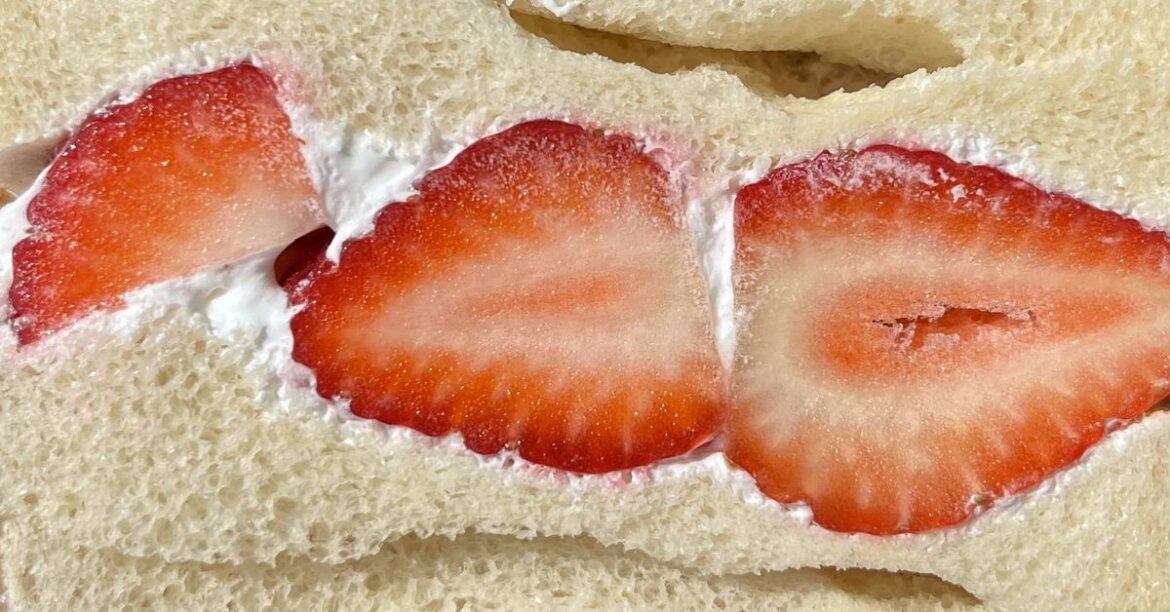HEB is typically praised for producing its own line of signature products, including its cult-favorite butter tortillas, myriad baked goods, and even the spicy boiled crawfish it supplies during prime-time crawfish season. In April 2025, however, the Texas supermarket chain faced some criticism on social media after releasing a “Japanese strawberry sando” in its sushi department.
Diners weighed in on social media and Reddit about HEB’s relatively pricey attempt at Japanese-style sandos, a type of sandwich that uses delicate and slightly sweet shokupan, or Japanese milk bread, which is popular in the various konbini (convenience stores) that dot Japan. HEB’s version, however, is an $8 assembly of whipped cream and strawberries squished between slices of the grocery store’s white Texas toast. “It’s like a simplified version of Japanese strawberry shortcake, since no baking is required. Not to mention that it’s easy to eat on the go,” the HEB app says of the new sandwich addition.
Reviews have been mixed: Many online commenters have pointed out that the sandwich does not seem “authentic,” criticizing HEB’s use of Texas white bread instead of the puffy milk bread the sandwiches are traditionally known for. Emily Hill, the influencer behind the Texas Grocery Finds blog and Instagram page, said the Texas toast didn’t pair well with the sweet filling, while others noted the price of the sandwich seemed to be too high. Some TikTok users, however, called it refreshing — a fun ode to the sandos commonly offered in Japanese convenience stores in both sweet and savory combinations. Texas fashion and food TikTok influencer Reba Lasha, who has more than 1.5 million followers, said that though the bread definitely tasted like white bread, she wasn’t mad at it. “HEB can do no wrong,” she said in a post that now has more than 29,000 likes.
One thing is for sure — people are willing to try the strawberry sando. TikTok and Instagram feature dozens of videos of people documenting their first bites; in some HEB stores around the Houston area, the sandwiches are frequently selling out. It took me two trips to a local HEB before I could finally secure one (it was one of only two sandwiches left). All in all, the sando was decent: The Texas toast’s center had the requisite softness, but the crust was dry and rough, taking away from the lightness of the sandwich. There could have been more cream, but the strawberries were amply sweet and the simplicity of the flavors felt refreshing. I brought my two-year-old for a second opinion: He was a fan, as indicated by the remnants of sweet cream all over his face, but he left the sando’s crusts untouched. The verdict: the sandwich served as an easy, quick snack on the go. For us, it is mostly a win.
With that said, better versions of Japanese-style sandos, especially in Texas, exist, but they aren’t cheap. In Austin, Choo Sando and Omakase offers a variety of sandos, including savory styles stuffed with tamago, lobster or chicken katsu, and dessert versions filled with fruit and regular whipped or matcha cream. Each Choo sandwich costs between $10 and $18, depending on the fillings. In Houston, Austin-born Japanese restaurant Uchiko serves a $28 short rib sando made with wagyu that’s braised for 72 hours. Kata Robata, similarly, serves a $21 Texas wagyu sando on toasted Japanese-style milk bread with the crusts cut off. It’s worth noting that Japanese-style sandos served on Texas toast aren’t entirely new: Vuji Cafe, a Tex-Asian sando shop in the Heights, already offers a variety of Asian diasporic sandwich combinations on Texas toast, as well as a dessert sando loaded with ube and pandan cream, ube foam, strawberries, Japanese wafer cookies, and marshmallows. Vuji’s sandwiches cost between $10 and $17.
Still, HEB’s Sushiya Sushi House, which produces the sandwiches, is considering shoppers’ feedback, according to a report by Chron.com. Sushiya launched in 2002 under the guidance of Glen Gondo and Hana Lee, owners of the Houston-based company Tokyo Gardens Catering. The company continues to provide the store’s sushi rolls, poke bowls, pot stickers, and other sashimi-grade seafood, according to HEB’s website. Robert Gondo, the president of Tokyo Gardens, told Chron.com that replicating a Japanese sando in a grocery store proved challenging because shokupan is the primary, albeit most fragile, component of the sandwich.
Considering this, and also wanting to maintain the sando’s freshness, Gondo says Tokyo Garden’s research team decided to use HEB’s bread, believing that shoppers would appreciate the use of a HEB product, despite it not being traditional. After the recent online discussions, however, Gondo says he’s willing to assess the feedback and see if future tweaks to HEB’s version can be made.
Still, Gondo says the strawberry sando is selling well. So while shoppers seem divided, there’s possibly reason for the grocery giant to continue experimenting with the form.
Sign up for the
newsletter
Eater Houston


AloJapan.com